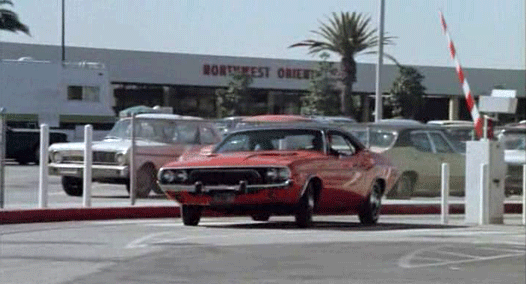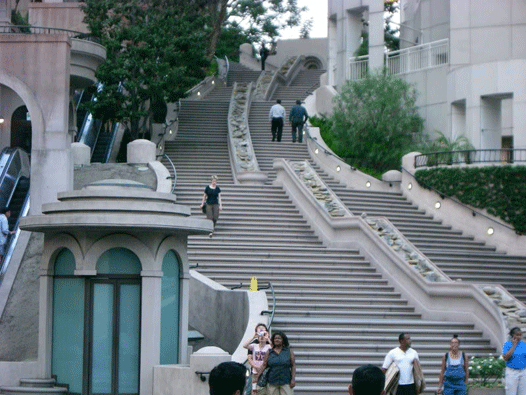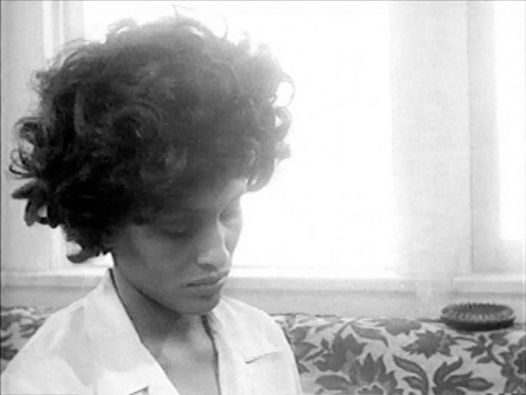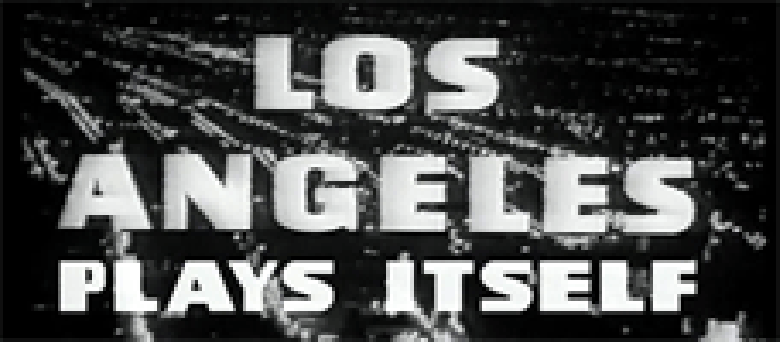Credits
Feature by: Evan Kindley
Posted on: 16 November 2009
Related articles:
Features
92YTribeca Film Series: Not Coming to a Theater Near You
To paraphrase Voltaire, if Los Angeles didn’t exist, it would be necessary to invent it. Well, it exists, of course (I’m sitting there as I write), but the invention has proven necessary anyway: since the early days of Hollywood the cinema has been representing, disguising, betraying, constructing, destroying and mythologizing the city most often associated with its own production. And while, for many outsiders, the City of Angels is nothing other than the home of the entertainment industry, there is life in Los Angeles beyond the movies. To highlight this extra-cinematic life and survey the zones where it overlaps with filmic representations is the project of Thom Andersen in his magisterial film essay Los Angeles Plays Itself. Excavating and annotating almost a century’s worth of films shot in Los Angeles, Andersen makes surprising connections, comes to controversial conclusions, and tells us new things about both the city’s history and the history of film.
NotComing.com will be hosting a screening of Los Angeles Plays Itself on Saturday, November 21st as part of our monthly series at 92Y Tribeca in New York City (and offer coverage related to the film throughout the week). As a prelude to the event, we met with Andersen in his home neighborhood of Silver Lake to discuss some influences on his filmmaking, the politics of nostalgia, and changing trends in the dwelling places of movie villains.
NotComing.com:
Though Los Angeles Plays Itself encompasses all kinds of films, from disaster movies to film noirs to silent comedies, you have a particular interest in neorealism. One might even say that you examine all of these types of films as if they were neorealistic—that is, as if they told us something about the time and place where they were made.
Thom Andersen:
There were two events that started me thinking about neorealism. In 1983, I was in Berlin and I was talking with a German filmmaker named Hartmut Bitomsky and he said, “For each film I make I have to discover a new method, but I always find myself coming back to neorealism.” What he said stayed in my mind.
And then around the same time I was reading Gilles Deleuze’s account of neorealism in The Time-Image. Deleuze regards neorealism as the foundation of all modern cinema—he has in mind films like the later works of Antonioni, or Resnais’ Last Year at Marienbad. It’s actually the idea that I expound in Los Angeles Plays Itself. There are passages in the film that are paraphrases of Deleuze’s ideas, particularly the section on [Haile Gerima’s] Bush Mama.
NCDC:
But you don’t refer to Deleuze, or any other theorists, directly in the film.
TA:
No, I don’t. I also paraphrase the psychologist Hugo Münsterberg early in the film, when I talk about voluntary attention and involuntary attention. I guess I assume that those references would be clear enough to people who have familiarity with film theory, but I wanted to formulate them in such a way that they would be accessible to people who had no knowledge of it. And I think I succeeded fairly well.
NCDC:
Another theoretical text your method puts me in mind of Roland Barthes’ Camera Lucida, with its distinction between studium—the meaning of a photograph, or you’re meant to be paying attention to – and punctum – the personally affecting detail, what moves or “pierces” you. That seems close to your way of viewing a lot of these films: you’re paying attention to something the filmmakers didn’t necessarily intend you to pay attention to.
TA:
I don’t think Barthes is proposing that this idea of punctum is something the photographers weren’t in some way concerned with. It’s not as if he’s talking about something that we discover in a photograph that was completely outside of the intentions of the photographer. He’s just drawing attention to a quality of photographs that hadn’t been acknowledged before. And I think the same thing applies to my film. Maybe the one interpretation I propose that would be completely foreign to the way the filmmaker himself looked at the film would be what I say about Gone in 60 Seconds by H.B. Halicki. But obviously he was conscious of making a film that was going against the grain of what was happening at that time, so I don’t think my interpretation is so out of line. I had occasion to talk to him about the film in 1988, when I had him come to CalArts and present the film. It was the first time he had been invited to a college or a university to talk about his work. Probably the last time, too.

NCDC:
Since I know how much you love that film, I was wondering if you had any thoughts on the 2000 remake.
TA:
Let’s just say it was soulless. I think a more interesting remake or commentary on Halicki’s work is the second part of Death Proof by Quentin Tarantino, which is an homage to Halicki’s second film The Junkman, and also an attempt to outdo Halicki. It was filmed in basically the same locations as The Junkman. Halicki regarded that film as a failure because he believed that you couldn’t do that kind of chase outside of an urban environment because you don’t have the same kind of obstacles that you have in Gone in 60 Seconds. So what Tarantino did was to take that as a challenge to make a car chase film in the countryside, trying to top Halicki. Which he succeeded in doing.
NCDC:
Tarantino is actually one of the conspicuous omissions from the film: you have scenes from Jackie Brown in there, but no references to Reservoir Dogs or Pulp Fiction, which are both set in Los Angeles.
TA:
Why wasn’t there more Tarantino? In a certain way it’s kind of a joke, to take a couple of contemporary directors whose films are associated with Los Angeles and instead of really talking about the films, treating them in this very offhand way. I did the same thing with Paul Thomas Anderson. You see a marquee for the old Magnolia Theatre in Burbank in Los Angeles Plays Itself. That was my reference to Anderson.
But I like Anderson’s films. I like Tarantino too. They have a different vision of cinema from me, but we have points where we agree.
NCDC:
There are also no references to any films made or set in the San Fernando Valley, where most of Anderson’s films take place.
TA:
It’s true. I talked about South Bay films but not Valley films, which obviously form their own subgenre as well. The reason I made that decision is that, at the time I was making the film, there was a movement for the Valley to secede from the city of Los Angeles. That didn’t happen, of course, but it wasn’t clear at the time what was going to happen, so I thought any kind of reference to the Valley in the movie was going to make it dated.

NCDC:
Your film takes its title from Fred Halsted’s 1972 gay porn movie L.A. Plays Itself. Did you ever consider including more of the pornographic films that have come out of Los Angeles?
TA:
I didn’t have the – shall I say – the stamina, the endurance, to study those in depth. I talked about L.A. Plays Itself because it was a film that, in its time, found a wider audience and had been celebrated as a work of art. So it was something I was aware of. But it would have been a lot of extra work to watch all of the pornographic films. Same thing with television, though I do include Dragnet, which seemed inescapable.
NCDC:
Another filmmaker who’s missing from Los Angeles Plays Itself is Kenneth Anger, who, like yourself, is a figure from the avant-garde with a great interest in Hollywood movies.
TA:
One reason I didn’t talk more about experimental or avant-garde films was that my friend David E. James’ book [The Most Typical Avant-Garde] was about to be published, and I just assumed that his accounts of those films would be definitive and I didn’t need to add anything. I do talk about Maya Deren and Alexander Hammid’s Meshes of the Afternoon, and about Andy Warhol’s Tarzan and Jane Regained… Sort Of, but specifically in terms of the sense of place in those films.
NCDC:
But you yourself have roots in the avant-garde. I wanted to ask you about the SUNY Buffalo Center for Media Study, which you co-founded in the late 70s along with a number of older experimental filmmakers like Hollis Frampton, Tony Conrad, and Steina and Woody Vasulka. I was curious about what influence you felt that experience had, if any, on what you do now, and a film like Los Angeles Plays Itself.
TA:
I’ve never actually thought that much about what’s influenced me, because, you know, everything has. But one person at Buffalo who certainly influenced me was James Blue, who was also one of my teachers at UCLA. He was a documentary filmmaker, a guy who’s pretty important in the development of the essay film in the United States. Particularly a film he made in 1968 for the United States Information Agency called A Few Notes on Our Food Problem. I don’t think it’s been seen by many people, because the USIA was essentially a propaganda organization for the U.S. government, and by law their films couldn’t be shown in the United States: they were shown abroad, under the auspices of various U.S. embassies.

Blue got recruited in the early 1960s by the head of the USIA, George Stevens, Jr., to make these kind of soft propaganda films. He made a film about the march on Washington in 1963 which was quite good [The March]: it’s essentially just a record, but it was a film that was very sympathetic to the civil rights movement. And then A Few Notes on Our Food Problem really was an essay film; he must have been working on it around the same time he was teaching at UCLA, and I was working on my first film [Eadweard Muybridge, Zoopraxographer]. He encouraged me and helped me with that.
NCDC:
It’s interesting that you can trace an influence on Los Angeles Plays Itself back to government propaganda films. You’ve mentioned that the government of the city of Los Angeles has liked the film, and considered you a kind of patriot, which is ironic because in many ways your film is very critical of Los Angeles.
TA:
Yeah. I made a video in 1995 with Noël Burch, Red Hollywood, which people often regard as a “didactic” film. Obviously it’s not really propagandistic, because it doesn’t represent the views of anybody except us. And there’s actually almost no narration in Red Hollywood, very little narration. We really kind of let the films speak for themselves: basically we just selected scenes from certain films and put them in a certain order. Whereas in Los Angeles Plays Itself, there’s a lot of narration, and it’s sometimes very opinionated. But it doesn’t get criticized in the same way for being didactic or propagandistic. It’s partly perhaps because the narration is established as first person, whereas in Red Hollywood it’s more traditional, impersonal third person narration. But I think it’s really more a question of politics: a lot of people find the point of view of Red Hollywood difficult to accept. In the last analysis, people respond to films politically more than they do aesthetically.
But I think Los Angeles Plays Itself is essentially a political film, too. Maybe in a way it’s more clever: it sets up all these smoke screens, establishes these points that people can accept and agree with this, and by the time it reaches arguments that should be more controversial people come to accept them.
NCDC:
You end the film on a political note, a very striking one, by highlighting films like Killer of Sheep, Bush Mama, and Bless Their Little Hearts that depict traditionally underrepresented populations, like the black population, in Los Angeles.
TA:
Well, the whole third part of the film [“The City as Subject”] is very political. I mean, in a way, the treatment of Bunker Hill in the second part is political as well. Oddly, though, that’s something that everyone agrees with. But I think there’s a kind of bad faith in that. People regard the destruction of this residential neighborhood on Bunker Hill as a tragedy, and what replaced it as horrible, but the city would do it all over again if a neighborhood like that still existed close to downtown. They did the same thing in what they call South Park just recently. The city has conducted this campaign for the past few years of trying to push the homeless people out of downtown Los Angeles, and there hasn’t been any great protest against that.

NCDC:
You think the agreement about the Bunker Hill development is nostalgia, rather than real political feeling?
TA:
To me it’s a false nostalgia. It’s something that I allude to in my commentary on Chinatown in the film: “History is written by the victors, but it’s written in crocodile tears.” We celebrate the losers. Martin Luther King, Cesar Chavez. People who were despised in their lifetimes. What they were fighting for was never achieved.
In fact, I kind of like parts of the new Bunker Hill. It provides some sublime vistas. Everyone seems to like Disney Hall. I mean, obviously, the buildings that Arthur Erickson created on Bunker Hill are maybe the worst things he ever did. Los Angeles has a way of bringing out the worst in some architects. It’s kind of the opposite of Chicago in that way. On the other hand, I would defend John Portman’s Bonaventure Hotel. Of course it’s a disorienting space, but no more so than Frank Gehry’s Guggenheim Museum in Bilbao. But when Gehry does it it’s art, and when Portman does it it’s a symptom.


NCDC:
Speaking of architecture, one of my favorite parts of the film is your discussion of the city’s modernist houses and the uses that Hollywood has put them to. You note that movie villains often live in modernist houses, in movies like Body Double, The Replacement Killers, and L.A. Confidential, for instance. But I noticed you gave a talk last year at the Hollyhock House called “Hollywood’s Anti-Modernism: An Update and Reconsideration.” Has your thinking progressed on this issue since you made Los Angeles Plays Itself?
TA:
My thinking hasn’t progressed, but I think there’s been a change or development in the way popular culture regards architecture. The film was essentially completed conceptually in 2001. But already in the 90s there was a little bit of a fad for modern architecture, in Los Angeles and elsewhere as well. It’s related to the rise of Wallpaper magazine, and Dwell, and a few others. There was a fad for modernism as a kind of retro style, as something that had passed. A kind of softened version of modernism: modernism with curves. And all these architects who started off in the 1920s, like Rudolf Schindler and Richard Neutra, were suddenly referred to as “mid-century modernists.” To a certain extent this change was reflected in a few Hollywood movies: the main characters in The Anniversary Party and in Laurel Canyon live in Neutra houses. So I’d say things are a little more ambiguous now. But there are still obviously villains living in more recent modern-style houses, like the The Glass House, or Hostage with Bruce Willis, or Fracture with Anthony Hopkins.

NCDC:
Partly as a result of the exposure provided by Los Angeles Play Itself, Kent Mackenzie’s The Exiles has just received its theatrical premiere, almost fifty years after it was made. How do you feel about having helped to unearth this movie?
TA:
Well, I don’t know exactly what my role was. The Exiles, like Killer of Sheep, was a film that was always hiding in plain sight. It was being distributed by the University of California Extension Media Center; they just did an indifferent job of it. They sold low-quality VHS copies. But there was a good print of the film in the USC Moving Image Archive Collection, which Jon Stout at Los Angeles Film Forum screened in the early 1990s. And David James at USC screened it around 1999. So there was this chain. I didn’t discover The Exiles, by any means. People here knew about it.
One thing that did happen was, when my movie came out, some people outside of the city showed programs based around it. So while the earlier screenings of The Exiles were mostly in Los Angeles, in the wake of Los Angeles Plays Itself it was also shown in other places all over the world. So other people discovered it, and a lot of critics were really impressed by it.
NCDC:
So you helped to bring it out of the local culture into the wider film culture?
TA:
Yeah. Of course its success is very personally satisfying to me.
NCDC:
Do you foresee other lesser-known films that you excerpt in Los Angeles Plays Itself getting similar treatment?
TA:
I hope Billy Woodberry’s Bless Their Little Hearts will also get some kind of DVD release at least. I think it’s as deserving as the others. Some people regard Bless Their Little Hearts as a greater film than Killer of Sheep. I think it’s certainly in the same league, let’s say.

Bush Mama is another film that’s in distribution, by Haile Gerima’s company, and there’s a quite good VHS copy that they sell. That one may be a more difficult film than these others, maybe a little rougher, more political in a way. More extreme, over-the-top—in the spirit of blaxploitation films, I guess. But it’s also a very important film, particularly for tracing the history of neorealism, and the way in which it developed from its origins through the 1970s.
NCDC:
Los Angeles Plays Itself is clearly a very personal film, containing many of your own insights and opinions as an inhabitant of the city over and above the information that you draw from the movies. Do you think you could have made a film like this about a place where you didn’t live?
TA:
I wouldn’t attempt it. I think it would be boring at best. The record of outsiders writing or talking about Los Angeles is not very inspiring.
NCDC:
I guess what I’m asking is, how important is the personal or subjective element of the film to you, as opposed to the historical or objective interest?
TA:
I can’t separate them. I take history personally.
We don’t do comments anymore, but you may contact us here or find us on Twitter or Facebook.



